Haenyo breathe life into dying trade
Text by Lynnette Ang Photography by Aaron Wong
South Korea’s aging sea women still dive for the ocean’s bounty

On this chillymid-July morning we arrive in Udo, bristling with anticipation. The tiny speck is just two miles (3.5km) off the eastern side of Jeju Island, South Korea, due south of the Korean peninsula in the East China Sea. Less than 12 miles (20km) around, you can cycle it comfortably in a day, but that’s not why we’ve traveled to this remote place. Inconspicuous though it may be, Udo is noteworthy on any world dive map as birthplace of the Haenyo, the legendary women free divers of South Korea.
Haenyo (pronounced hen-yuh), means ‘sea women’ and the esteem in which they’re held in this culture is immediately apparent; they’re revered and they’re a big attraction here. Not unlike on Jeju Island, we see numerous stone statues of the women, some in wetsuits and others sporting the simple cotton shirts and trunks they wore in the early days. There are tour packages that include Haenyo ‘shows’. Jung, our burly host and guide, tells us that the Haenyo now routinely demonstrate their skills, their way of life, in a bid to preserve the dying culture. From traditional singing to diving and harvesting, the women perform different activities for visitors and the lucky ones will enjoy a lunch of raw octopus, abalone or other seafood that is fresh like no other!
The Haenyo are skilled at breath hold diving to depths of 60 feet (20m) or more for two minutes, give or take, to harvest and supply abalone, conch, sea urchin, octopus and seaweed to the country’s demanding seafood industry.
Originally, men performed this work but heavy taxes made it unprofitable, so as a way around this women took over the diving duties. In time, the Haenyo became central in a matriarchal family structure. For the Haenyo the 1970s was an abundant time of seafood exports, mostly to Japan, that earned the women a monthly income of $150 to $200, allowing them to send even their daughters to school, and to afford other comforts of the communal Confucian society. Sadly, the highly regarded occupation is tapering off in this contemporary age. The Haenyo, 30,000 strong just 50 years ago, are fewer than 2,000 in number today. Perhaps the obvious conclusion to draw is that the efficiencies of commercial fishing have sidelined this time-honored trade of harvesting by hand.
I am surprised to learn of Haenyo ‘shows’. Prior to our visit, I’d heard that the women were a guarded and tight-lipped bunch, unwelcoming of intrusion. I ask Jung if this is no longer the case and with a laugh he points out the distinction between a ‘performing’ Haenyo and the real Haenyo, who are not in the entertainment business. In fact, they’re all legitimate Haenyo but the performers are more open to interaction with visitors.
We drive along winding gravel roads, enjoying the beautiful green of Udo. Occasionally, we see modest little huts made of dark lava stone called ‘Haenyo Hostels’, though there are no welcome signs or anything to suggest their purpose. Built years before in a time when the Haenyo were not able to afford their present lifestyle in coastal settlements, the tiny shelters were a home away from home where the hardworking women would stay for days at a time, next to the sea, making dives as and when opportunities arose.
(Click image to enlarge)
The Real Haenyo
Jung receives a phone call telling us of a nearby group of Haenyo preparing to dive. The first diver I see is small of stature and bent over, her slow gait seems almost painful. Roughened fingers grip an old pram, now a gear trolley loaded with a well-worn wetsuit, fraying weight belt, dive fins and mask. This is not the popular image of the Haenyo. I understood the women to be older but the common perception is of a tenacious breed, agile and able to handle strong currents and to brave the depths. This woman with her head of curly grey hair looks more retired than robust.
As we near the stone hut she notices our little group but does not acknowledge us. Stoically, she ambles on. By now other Haenyo see us and, unabashedly, seem to be sizing us up. They are openly curious. This group appears to be younger – 50 to 60 year old – divers mostly. Weathered skin masks age well but several heads of black hair are revealing. A pet puppy that greets us is quickly retrieved and mostly the women ignore us. No smiles, no handshakes, no “Annyeonghaseyo”, hello in Korean.
We’ve been standing around for about 20 minutes feeling a bit awkward. We don’t want to intrude further but we have a million questions to ask. Suddenly, there’s a shrill cry from an older Haenyo who’s displeased by our presence and she gestures violently for us to go. At the same moment another Haenyo approaches Jung and speaks softly to him before turning to us with a gesture to leave. I am crushed. It’s not even midday and already an obstacle.
Back in the truck, Jung explains that the upset elder is Kim, at 82 the oldest in the group and the second oldest Haenyo on Udo. The eldest Haenyo is 85 and retired, making Kim the oldest working diver on the island. She commands respect and her displeasure with us is a signal for the others to refrain from any contact. “But you met Mama Woo,” Jung says with a grin, “so you are very lucky.”
We are, indeed. It turns out that Mama Woo is the mother of Jung’s best friend. She assured him of her help if we return the next day when Kim is scheduled to be at a doctor’s appointment on Jeju Island.
Fluid Grace
The next day we arrive at the same hut armed with notebooks, cameras and dive gear. We sit close by but maintain a respectful distance. The mood is considerably lighter, although most of the women still pay us scant attention. Sitting there in silent observation we are struck by the camaraderie between the women. Little is said. There are subtle nods of greeting among them and helping each other gear up is automatic. It’s evident they are very close. The bond is strong.
Aaron spots Mama Woo already in her suit and she’s rubbing the glass lens of her traditional mask with a plant that’s unfamiliar to us. It’s called leaf sap and has been their defogging agent for ages. Her gear is amazingly primitive and to us some of it looks rather makeshift; a bicycle inner tube now serves as her mask strap, but to the Haenyo it’s a tried and true replacement part. She catches our attention and points to Aaron’s gear, indicating we should follow as she moves toward the sea with the others. My eyes are fixed on her as she settles herself on one of the many black volcanic rocks at water’s edge. Momentarily, she gazes at the familiar horizon, before slipping on fins and mask. Then, she turns and looks at us with a knowing glance, flashes the briefest of smiles, and is gone beneath the surface. As if choreographed all the women follow and in what seems a kind of metamorphosis, they shrug off the awkwardness of their aging bodies as they slip into the familiar world of water, moving with an ease and fluid grace that few of us could match.
Though he’s been gearing up quickly to join them the sea women leave Aaron in their dust so he’s now scrambling to catch-up. Later he recalled that underwater they were like aquatic creatures grazing over a marine pasture. Often he would have to quickly move out of the way when one of the women would fin vigorously at him zeroing in on a ‘treasure’ that, quite literally, he’d been kneeling on. Then, after a minute or more harvesting on the bottom, the diver would ascend and be lost in the mix of colorful fins of the group floating at the surface. Unlike the form-conscious competitive free diver, the Haenyo move using swift, efficient strokes that are practical more than elegant. He likened them to the marine iguanas of Galápagos – slow and awkward on land but quick, agile and in their element underwater.
As the Haenyo dive the air is filled with the symphony of ‘sumbisori’, the whistle-like sound they make exhaling air as they break surface. The practice has long been a part of their diving technique. When they’re diving the women use a ‘taewak’, typically a high visibility polystyrene buoy that serves as a float to grasp for a little rest and for the ‘mangsiri’, a cylindrical net that hangs below and slowly fills with the day’s catch.
The Haenyo work territories that are determined by team and rank. On Udo there are 12 teams and rank within each is by a kind of natural selection. The stronger and more experienced earn the right to go furthest out at sea where conditions are more challenging, the water is deeper, but where the catch is better also. By this system a Haenyo’s career peaks between the ages of 30 and 50. But as their numbers dwindle the women 55 to 70 years of age now find themselves furthest out to sea.
At 66, Mama Woo is one of the highest ranking in her team but, paradoxically, earns less because old age dictates that she spend less time in the water, which nets a smaller catch. Her advancing years also mean that before long she’ll be obliged to work shallower waters, where she will have to vie with a comparatively larger number of teammates for jellyfish and crops such as seaweed.
Like many of her Haenyo friends, she worries about these things and the continuity of her trade. As I watch the women dive and surface from the shore a commercial fish boat appears on the horizon; it’s a harbinger of the relentless change facing the women, or so it seems.
(Click image to enlarge)
Diminishing Appeal
That night, after much pleading and cajoling, Mama Woo agrees to join us for dinner at a traditional Korean barbeque shop. Dressed in her favorite purple and with newly painted nails to match, she sits and is at first shy and reserved, turning away from the camera, mostly just laughing softly at Jung’s jokes. That is, until we asked her about her job as Haenyo.
She says that at 66 years of age she’s been a Haenyo for 52 years, and is very proud of it. Descending from a long hereditary line of Haenyos, she is considered ‘pureblood’ whose mother was a leading Haenyo, as was her mother before, and down through generations of women in her family.
She tells us the job is no longer as interesting and enjoyable as when she was younger and more able-bodied. At an age where most western women are kicking back to relax in their senior years, she worries for her health and safety in the harsh and challenging environment. Working her usual four-hour shift immersed the entire time in water close to freezing is one thing, especially given the relatively primitive suits they wear. But these days she and her fellow Haenyo must also contend with commercial fishing boats in the waters they share. There have been and continue to be close calls, accidents and even the occasional fatality.
When I ask her about the threat posed by commercial fishing and their sizeable catches, she looks at me with bewilderment. For a moment she remains silent, gathering her thoughts, and then tells us the sad reality is not what it seems. The Haenyo’s fresh catch, she says, sells for premium prices. It’s in demand, practically a brand unto itself that earns even better income for the divers than before, but this is not incentive enough to attract new blood. The problem, she tells us, is not with commercial fishing; it is that the younger generation of Udo no longer wants to be Haenyo.
It’s a dire situation. The average age of working Haenyos today is approximately 65 years, the youngest about 50. Mama Woo is passionate about her work, calloused hands waving about animatedly as she recounts joining the Haenyos against her mother’s wishes. Even though her family’s finances were stable she insisted on becoming a sea woman. At the tender age of 14, her start-up gear was determination, a love of the ocean and friends equally excited and determined to become Haenyo. Sadly, she laments, it’s been a very long time since that voice of enthusiasm has been heard among the culture’s young people.
Dying Trade
It appears the Haenyo themselves are not the only ones worried about their vanishing trade. The Jeju Provincial Government offers incentives to become Haenyo, providing fully subsidized medical coverage that includes regular check-ups. Their equipment is paid for as long as they continue working, however, the aging gear they wear is preferred because it is ‘well seasoned’ and perhaps also because of a frugal mindset. Haenyo also enjoy substantial monthly pensions and continued health care after retirement.
Today’s Haenyo want their daughters to keep their trade alive but are reluctant to push it because they equate the absence of passion with ability. Without the one, the other is missing. Their hope is that others will become sea women. For its part the better-educated younger generation fails to see the appeal of the wetsuit over the business suit. The pen, the computer, the contemporary world of commerce holds far more allure than damp rubber suits, masks and fins.
And little is done to alter this perception. Mama Woo tells us that her only daughter, Mul, refuses to follow in her footsteps. Rather, the 34-year-old, whose name means ‘water’, prefers to work on Jeju Island as a retail assistant for a cosmetics chain. She shrugs, saying matter-of-factly that Mul will not last as Haenyo if there is no passion.
The day has faded into darkness. From our window, the sea reflects the waxing crescent moon. I am holding Mama Woo’s hand, my heart sad for her and the legendary free diving women of South Korea. For generations they’ve passed down their skills but now see the day will come when their ancient tradition born of the sea so long ago, will be embodied only in the stone statues that remember the Haenyo.
(Click image to enlarge)
2 Responses to “Haenyo breathe life into dying trade”
Leave a Comment

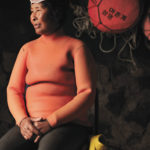
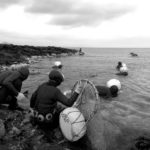
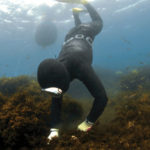
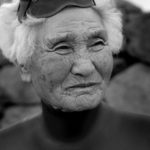
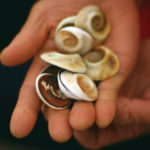
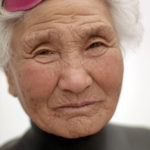
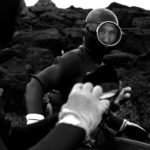

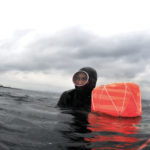
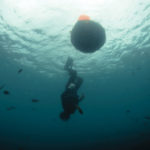









Dawn Salka
I am interested in having Lynnette Ang or another from DAN to present on the Haeyno divers at the UHMS NE chapter meeting in Stamford, CT 10/23-25, 2015. Please contact me at your earliest convenience. Thank you.
Leenson Daniel
I am interesting in Haenyo, but I am disappointed about ancident tradition is fall…Thank